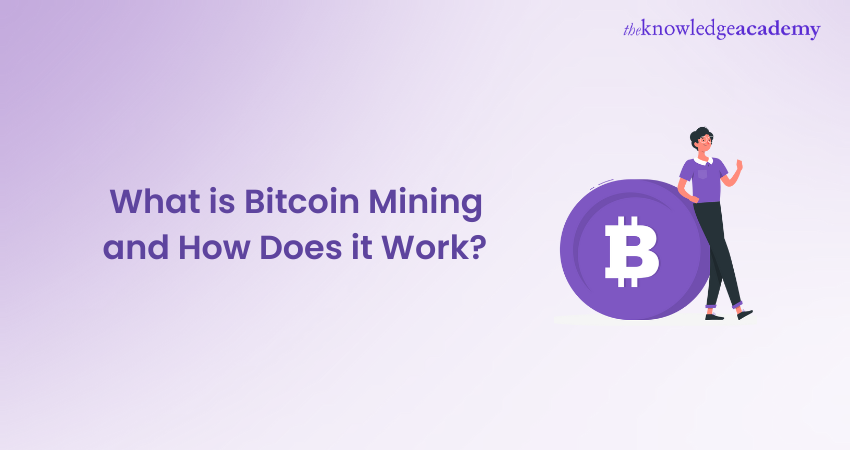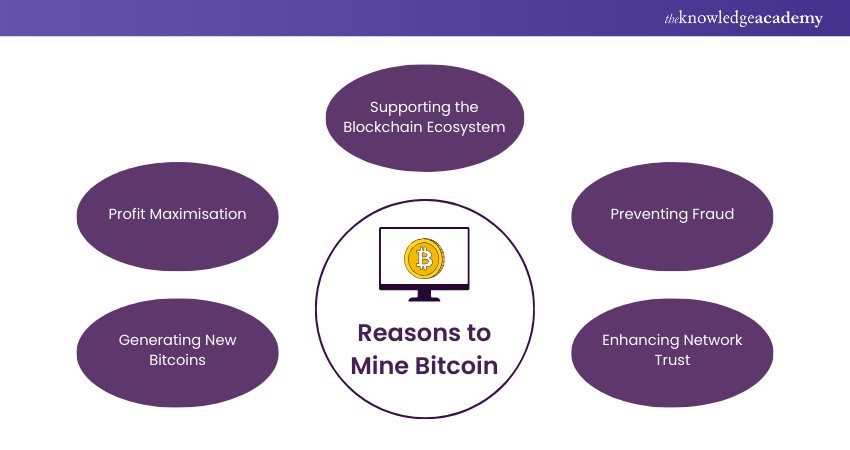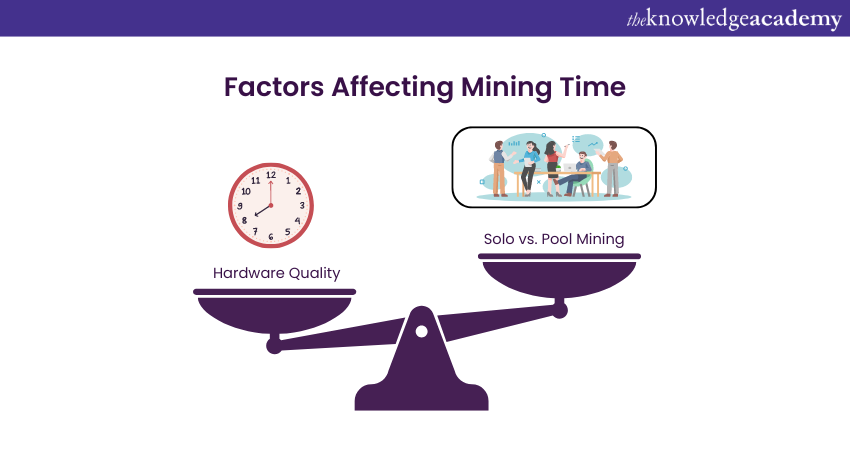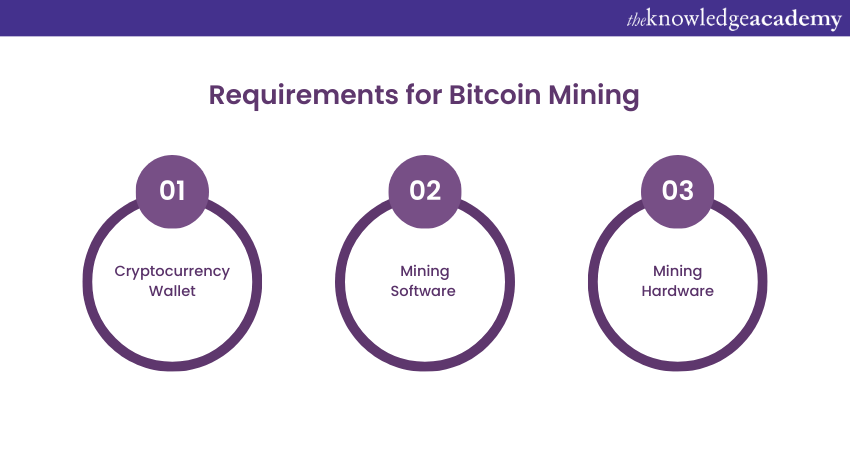We may not have the course you’re looking for. If you enquire or give us a call on +33 805638382 and speak to our training experts, we may still be able to help with your training requirements.
Training Outcomes Within Your Budget!
We ensure quality, budget-alignment, and timely delivery by our expert instructors.

In the current economy, who wouldn’t enjoy an alternative new way to finance one’s lifestyle? With Bitcoin (BTC) gaining the popularity it did in the last decade, Bitcoin Mining became the most efficient way to do so.
First launched by Satoshi Nakamoto in 2009, soon catching on as the leading digital currency. It was alternatively called Cryptocurrency. It eliminated the need for a centralised body like the government or bank to be involved in peer-to-peer transactions.
To participate in such a transaction, you will need Bitcoins. A great way to avail them is Bitcoin Mining. Read along to know what is Bitcoin Mining and how it works to kick start your journey with alternative financing.
Table of Contents
1) What is Bitcoin Mining?
2) Process of Bitcoin Mining
3) Methods of Bitcoin Mining
4) What is Proof of Work in Bitcoin?
5) Why to do Bitcoin Mining?
6) Time Taken to Mine One Bitcoin
7) Requirements for Bitcoin Mining
8) Cost of Bitcoin Mining
9) Why are Bitcoin Miners needed?
10) Conclusion
What is Bitcoin Mining?
Bitcoin mining is like a digital treasure hunt in which the prize is Bitcoins. Miners use high end powerful computers to solve complex mathematical puzzles. This process, called 'hashing,' is part of Proof of Work (PoW) and requires a lot of energy, putting a significant strain on computer parts like graphic cards.
In hashing, miners make numerous quick guesses to find the right answer to a puzzle. As more miners join, the puzzles become harder, requiring even more computing power. This ensures that transactions are verified and the network remains secure, rewarding successful miners with Bitcoins.
However, Bitcoin mining consumes a large amount of energy, raising concerns about its environmental impact. This has led to discussions on developing greener and more efficient methods to sustain Bitcoin mining.
As miners continue their quest for Bitcoins, the future remains uncertain. Will innovations make mining more sustainable, or will the demand for digital currency keep pushing the limits of technology and energy use? Only time will tell.
Process of Bitcoin Mining
Now that you know what Bitcoin Mining is, you must be curious about how you can join this online treasure hunt! Here is a detailed explanation of how you can start mining Bitcoins:
1) Joining the Network: Connect your computer to the Bitcoin network. This network is a decentralised system where all transactions are recorded on a public ledger. This ledger is popularly known as the blockchain.
2) Solving Puzzles: Your computer starts working on solving complex mathematical puzzles. This process is called 'hashing.' Think of it as making millions of guesses per second to find the correct answer or the closest one to a specific problem.
3) Proof of Work (PoW): These puzzles are part of the Proof of Work (PoW) system. It ensures that miners (like you) put in computational effort to validate transactions. Each time you solve a puzzle, you’re essentially verifying a batch of transactions and adding them to the blockchain.
4) Competition: You’re not alone in this quest. Thousands of other miners are also trying to solve the same puzzle. The first one to find the correct answer gets to add a new block to the existing blockchain and is then rewarded with Bitcoins.
5) Rewards: When you successfully solve a puzzle and add a block, you earn Bitcoins as a reward. This is your incentive to contribute to the network's security and transaction verification.
6) Energy Consumption: Keep in mind this process consumes high amount of energy and can be quite expensive. It requires continuous operation of your hardware, leading to significant electricity usage.
7) Increasing Difficulty: The more miners that join the network, the puzzles become harder. This adjustment ensures that Bitcoins are mined at a steady rate, roughly every 10 minutes.
8) Sustainability Concerns: The high energy consumption of mining has raised environmental concerns. There’s ongoing research and development aimed at finding more sustainable and efficient mining methods.
Methods of Bitcoin Mining
Here, we have discussed some of the several methods available to Bitcoin Miners to mine BTC:
a) Application-Specific Integrated Circuits (ASIC) Mining - These computers have been designed to serve only one purpose: To mine Cryptocurrency like Bitcoin. It is a highly effective means of mining cryptocurrencies.
b) Graphic Processing Unit (GPU) Mining - This mining method serves more purpose than ASIC. This method is helpful because a GPU can serve as a lower model of entry in the Cryptocurrency mining world. These are more affordable than the ASICs and can also support standard hardware.
c) Central Processing Unit (CPU) Mining - A CPU is the main part of any computer system. The method of CPU mining allows miners to use the idle power of their systems to mine Cryptocurrency. In the beginning, Bitcoins were mined using CPU power only.
d) Mining pools - This is another method of mining where several miners join their resources to form a pool and mine the Cryptocurrencies. As many miners work together, finding a new block increases. Once the new block is found, these miners share the profit, and thus, collectively, they also increase their earnings.
e) Solo mining - It is the exact opposite of Mining pools. Here, only one person is involved in the mining process. The single individual bears all the costs and profits of mining alone.
f) Cloud mining - In this method, the miner outsources their computational work to a cloud mining farm. The miner or the user pays someone else to mine on their behalf. Starting the mining process becomes easier with cloud mining because the miner does not have to procure or arrange specialised hardware for mining.
What is Proof of Work in Bitcoin?
Proof of Work (PoW) is a system used to validate the transactions made and add new blocks to Bitcoin's blockchain. It ensures decentralisation by eliminating the need for government or bank intervention.
In PoW, the miners are required to solve complex mathematical puzzles to generate a hash that matches a target hash. The first miner to achieve this gets to add a new block to their blockchain and earn a Bitcoin as a reward. This process secures the network, prevents double spending, and keeps a record of all transactions.
Bitcoin introduced PoW, which is known for its high security but is criticised for its inefficiency and environmental impact. The PoW model, using the SHA-256 hashing algorithm, requires significant computational power, ensuring that only legitimate transactions are validated and respectivly recorded on the blockchain.
Preparing for a Job Interview? Check out our Blockchain Interview Questions!
Why to do Bitcoin Mining?
Bitcoin mining serves multiple crucial roles in the cryptocurrency ecosystem beyond just being a source of income for miners.

a) Generating New Bitcoins
The primary way to generate new Bitcoins is through mining. When Bitcoin was launched, it was initially circulated through the Genesis block, created by Satoshi Nakamoto. Since then, every Bitcoin has been generated and released through the mining process. Without miners, the Bitcoin network would exist but would be unusable because no new currency would be minted.
b) Maximising Profit
Mining Bitcoins can be highly profitable, especially given the high market value of Bitcoin today. Purchasing Bitcoin can be expensive, so miners can maximise their earnings by generating new Bitcoins through mining. With fewer than two million Bitcoins left to be mined out of the 21 million cap, their value is expected to increase, making mining potentially even more lucrative.
c) Supporting the Blockchain Ecosystem
Mining is important for maintaining and securing the Bitcoin network. Miners validate transactions, preventing fraud by ensuring that each Bitcoin is only spent once. This process involves solving complex puzzles, which help to confirm and record the transactions on the main blockchain. As their reward for their work, miners receive Bitcoins, incentivising them to continue supporting the network.
d) Preventing Fraud
Without miners, the Bitcoin network would be highly susceptible to fraud. Fraudsters could potentially spend the same Bitcoin more than once if transactions were not validated. The mining process reduces this risk, enhancing the confidence and trust of both miners and users in the Bitcoin blockchain.
e) Enhancing Network Trust
Miners play a critical role in building trust within the Bitcoin ecosystem by validating transactions and maintaining the integrity of the blockchain. This trust is fundamental for the continued adoption and stability of Bitcoin as a form of digital currency.
With our Blockchain Training Course, you will learn technologies behind Cryptography, Bitcoin, Ethereum, and others.
Time Taken to Mine One Bitcoin
The creator of Bitcoin, Satoshi Nakamoto, designed the system to mine a new block every 10 minutes. To keep this pace, the difficulty of solving the puzzles adjusts based on the number of miners: more miners mean higher difficulty and vice versa.
Factors Affecting Mining Time

Hardware Quality: Advanced mining equipment can solve puzzles faster, earning Bitcoins more quickly.
Solo vs. Pool Mining: Solo mining takes more time since you work alone. Joining a mining pool speeds up the process as miners combine resources for better equipment and share the workload.
Requirements for Bitcoin Mining
Bitcoin mining is a complex process, as it requires technical knowledge and access to various hardware and software. It involves three main components:

a) Cryptocurrency Wallet:
1) A miner needs a cryptocurrency wallet to store the keys for tokens or coins obtained from mining.
2) Wallets have unique addresses for sending, receiving, and securely storing tokens.
3) Options include online wallets and 'cold storage' wallets (offline). Each has its pros and cons.
b) Mining Software:
1) Mining software, usually free and available for different operating systems (OS), is essential for the mining process.
2) The miner must choose compatible software to avoid issues that could affect mining efficiency.
c) Mining Hardware:
1) Miners select hardware based on their needs and budget. Options range from personal computers (slow) to specialised, high-performance equipment (expensive and sometimes imported).
2) The right hardware simplifies and enhances the mining process.
Want to learn how to use a managed Blockchain Network quickly? Join our Amazon Managed Blockchain Training course today!
Cost of Bitcoin Mining
a) Mining Cost: The expense of mining a single Bitcoin varies significantly based on the energy rate per kilowatt-hour (kWh) and the efficiency of the mining hardware. For instance, at a rate of 4.7 cents per kWh, mining one Bitcoin costs roughly $5,170, whereas at 10 cents per kWh, it totals around $11,000. The substantial energy consumption required for mining is exemplified by an ASIC miner consuming about 3,032 watts to mine one Bitcoin, equating to a cost of roughly $10,200 at 5 cents per kWh.
b) Hash Rate Growth: With more number of miners joining, the hash rate increases, making Bitcoin mining more challenging and costly. This trend can lead to decreased profitability for individual miners. To mitigate the risk of not solving the cryptographic puzzle and enhance the chances of earning a reward, many miners opt to join mining pools. However, this also means that the reward is divided among the pool members.
c) Cost Components: Capital expenses (CapEx) such as purchasing and maintaining mining hardware significantly contribute to the overall mining cost. For example, the cost of an ASIC miner can be around $4,600, making the effective price per Bitcoin approximately $14,300. Operational expenses (OpEx) like electricity costs, cooling, and other overheads further add to the total cost. For instance, the electricity cost per Bitcoin can amount to around $10,200, resulting in a total production cost per Bitcoin of approximately $26,500.
d) Profitability Challenge: The profitability of mining Bitcoin is influenced by factors such as production costs, Bitcoin's price, and the network hash rate. It can be challenging for small-scale miners to optimize production costs enough for mining to be highly profitable.
Join Blockchain Training courses to learn the basics of Bitcoins and Blockchain Technology!
Why are Bitcoin Miners Needed?
Bitcoin mining goes beyond creating new Bitcoins; it validates cryptocurrency transactions and maintains their records. Miners play a crucial role in preventing double-spending, which is akin to counterfeiting. Satoshi Nakamoto designed the Proof of Work (PoW) system to ensure that each Bitcoin is only spent once.
Miners validate their transactions and add them to the blockchain in blocks. This prevents cybercriminals from reusing already spent Bitcoins, as each transaction is checked against a public ledger. This validation process is helps with maintaining the integrity of the Bitcoin network.
Moreover, Bitcoin miners collectively secure the network. More miners mean increased security, reducing the risk of fraud. A secure network attracts more users, encouraging the widespread use of Bitcoin for various transactions.
Earnings of a Bitcoin Miner
Bitcoin mining rewards are halved every four years or 210,000 blocks. When Bitcoin launched in 2009, the reward was 50 BTC per block. This was later reduced to 25 BTC in the year 2012, 12.5 BTC in 2016, and currently stands at 6.25 BTC since the 2020 halving. In 2024, the reward will further decrease to 3.125 BTC. Despite these reductions, the value of Bitcoin fluctuates daily.
Currently, earning 6.25 BTC per block still represents significant income, given that one Bitcoin is valued at approximately £22,000. However, Bitcoin's value is highly volatile and can change rapidly. Many experts predict a dramatic increase in Bitcoin's value in the near future, potentially boosting miners' earnings and making the mining process even more profitable.
Conclusion
With the rising popularity of Cryptocurrencies and Bitcoin in particular knowing how Bitcoin Mining works can be a great benefit. This blog explains the concept and process of Mining Bitcoins in great details. It additionally provides insight into the different methods, requirements and costs involved in Bitcoin Mining. So, wait no longer gear up your systems and start your journey of this unique online treasure hunt.
Gain in-depth knowledge of Cryptocurrency and how to trade with the Trading and Investing Training course.
Frequently Asked Questions

The legality of Bitcoin mining varies by country. In many places, it is legal, but in some countries it has been banned or restricted it due to the concerns about its energy consumption and regulatory issues.

Approximately 2 million Bitcoins are left to be mined out of the total 21 million. As of now, over 19 million Bitcoins have already gotten mined.

The Knowledge Academy takes global learning to new heights, offering over 30,000 online courses across 490+ locations in 220 countries. This expansive reach ensures accessibility and convenience for learners worldwide.
Alongside our diverse Online Course Catalogue, encompassing 17 major categories, we go the extra mile by providing a plethora of free educational Online Resources like News updates, Blogs, videos, webinars, and interview questions. Tailoring learning experiences further, professionals can maximise value with customisable Course Bundles of TKA.

The Knowledge Academy’s Knowledge Pass, a prepaid voucher, adds another layer of flexibility, allowing course bookings over a 12-month period. Join us on a journey where education knows no bounds.

The Knowledge Academy offers various Advanced Technology Courses, including the Bitcoin and Cryptocurrency Course, Ethereum Developer Course, and Cryptocurrency Course. These courses cater to different skill levels, providing comprehensive insights into Types of Blockchain.
Our Advanced Technology Blogs cover a range of topics related to Bitcoin, offering valuable resources, best practices, and industry insights. Whether you are a beginner or looking to advance your Crypto skills, The Knowledge Academy's diverse courses and informative blogs have got you covered.
Upcoming Business Skills Resources Batches & Dates
Date
 Bitcoin and Cryptocurrency Course
Bitcoin and Cryptocurrency Course
Thu 27th Feb 2025
Thu 10th Apr 2025
Thu 26th Jun 2025
Thu 28th Aug 2025
Thu 23rd Oct 2025
Thu 4th Dec 2025







 Top Rated Course
Top Rated Course



 If you wish to make any changes to your course, please
If you wish to make any changes to your course, please


